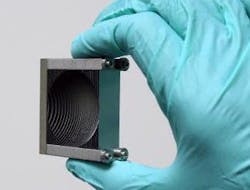Researchers from Brown University (Providence, RI) have developed a lens for focusing terahertz radiation that is made up of an array of stacked metal plates with spaces between them. The lens performs as well or better than existing terahertz lenses, and the architecture used to build the device could set the stage for a range of other terahertz components that don’t currently exist.
The new lens is made from 32 metal plates, each 100 μm thick, with a 1 mm space between each plate. The plates have semicircular notches of different sizes cut out of one edge, such that when stacked horizontally the notches form a spherical indentation on one side of the device.
Using the configuration developed for this new study, the researchers were able to focus a 2-cm-diameter terahertz beam down to a 4 mm spot. The transmission efficiency of the lens was about 80%—significantly better than silicon lenses, which typically have a transmission loss of about 50%, and about the same as lenses made from Teflon.
The new device has some advantages over existing Teflon lenses, however. In particular, by changing the spacing between the plates, the lens can be tuned for specific terahertz wavelengths.
"That can be particularly interesting if you want to image things at one frequency and not at others," says Dan Mittleman, a professor of engineering at Brown. "One of the important things here is that this design offers you a versatility that a simple chunk of plastic with a curved surface doesn’t offer."
The work also suggests that the technique of using spaced metal plates to manipulate terahertz radiation could be useful in making other types of components that currently don’t exist. Since a metallic architecture mimics a dielectric, this material technology is termed "artificial dielectrics."
The same technology could be used, Mendis said, to make a polarizing beamsplitter for terahertz waves. Such a device could be used to implement elementary logic gates for terahertz photonic systems, where the binary logic states are assigned to the two polarization states, forming part of a terahertz data network.
About the Author
John Wallace
Senior Technical Editor (1998-2022)
John Wallace was with Laser Focus World for nearly 25 years, retiring in late June 2022. He obtained a bachelor's degree in mechanical engineering and physics at Rutgers University and a master's in optical engineering at the University of Rochester. Before becoming an editor, John worked as an engineer at RCA, Exxon, Eastman Kodak, and GCA Corporation.

